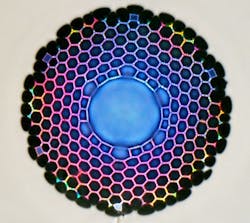University of Southampton to lead EPSRC-funded hollow-core optical fiber project
The University of Southampton's Optoelectronics Research Centre (ORC; Southampton, England) is to lead a (6.1 million pound) nearly 8.2 million dollar Engineering and Physical Sciences Research Council (EPSRC)-funded program to develop the next generation of fiber optics and position the UK as a world-leader in this technology.
RELATED ARTICLE: Hollow-core gas-filled fiber laser reaches 3 micron mid-IR region
Bringing together expertise from Southampton's ORC and more than 25 research organizations and industry partners, the new AirGuide Photonics program will transform future optical fiber networks and generate enormous potential for a multitude of uses ranging from a faster more responsive internet, through space exploration, to laser-based manufacturing and bioengineering.
Today's conventional optical fibers contain a glass core at the center of the fiber through which light is transmitted. However, not only does this glass center limit the speed of the light as it passes through, but it also adversely affects other aspects of its propagation, thereby limiting the performance of the fiber and the associated optical system. AirGuide Photonics will replace this conventional glass core with air, or a vacuum, to produce hollow-core 'light pipes'. By guiding light through air, rather than through glass, these new optical fibers offer increased bandwidth with lower latency, greatly improved power handling, and improved overall quality of light transmission.
The new program will investigate and explore the performance limits of hollow-core fiber technology. It will also develop innovative means of manufacturing and reliable methods of interconnecting these new optical fibers to other more conventional fiber types as well as other optical components such as lasers.
To maximize the impact of the research, the program will also develop and demonstrate application-specific fibers based on the project partners' particular interests and will work with the partners to demonstrate real-world uses of the technology that will serve to showcase its unique and enabling properties.
Professor David Richardson, programme lead for AirGuide Photonics and deputy director of the University's ORC said, "The ORC has been at the forefront of photonics for over 40 years. Our new AirGuide Photonics programme will continue to push the boundaries of what can be achieved with optical fibres and develop a disruptive technology that puts the UK at the forefront of optical technology."
Professor Tom Rodden, deputy chief executive of the EPSRC said, "The ORC has been pioneering the development of fibre optics and advancing communications technology for many years and has an impressive record of using research funding to collaborate with academic and industry partners. EPSRC has consistently supported research at the ORC and the new AirGuide Photonics programme promises to push at the boundaries once more. We are confident that the research will uncover more discoveries and lead to world-leading innovations."
The ORC says it has built strong links with industry, research institutions, and universities around the world, from informal collaborations to large-scale funding. In 2014, it launched The Photonics Institute with Nanyang Technological University (NTU) in Singapore. Ten spin-out companies, including Fibercore, Fianium, SENSA, SPI Lasers, and Stratophase have commercialized ORC research, while its outreach program has brought light technologies into schools across the country.
SOURCE: University of Southampton ORC; https://www.orc.soton.ac.uk/news/5527
About the Author

Gail Overton
Senior Editor (2004-2020)
Gail has more than 30 years of engineering, marketing, product management, and editorial experience in the photonics and optical communications industry. Before joining the staff at Laser Focus World in 2004, she held many product management and product marketing roles in the fiber-optics industry, most notably at Hughes (El Segundo, CA), GTE Labs (Waltham, MA), Corning (Corning, NY), Photon Kinetics (Beaverton, OR), and Newport Corporation (Irvine, CA). During her marketing career, Gail published articles in WDM Solutions and Sensors magazine and traveled internationally to conduct product and sales training. Gail received her BS degree in physics, with an emphasis in optics, from San Diego State University in San Diego, CA in May 1986.
